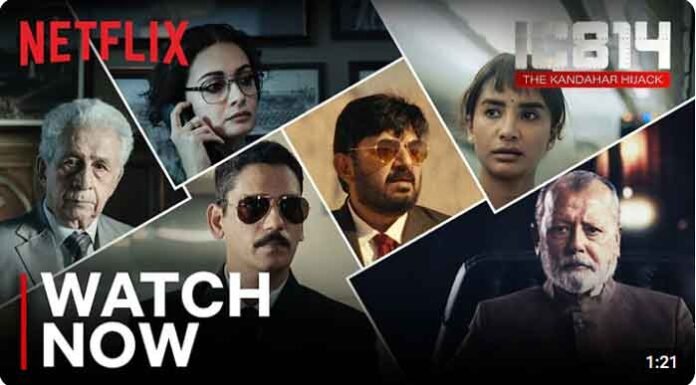
INVC NEWS
New Delhi :The latest controversy surrounding Netflix’s “IC 814: The Kandahar Hijack” has caused an uproar over the portrayal of Hindu names for terrorists. The Ministry of Information and Broadcasting has summoned the Netflix content head, seeking clarification. Read on to explore the unfolding drama and the political reactions to the series.
In recent days, the digital landscape in India has been buzzing with controversy over Netflix’s latest web series, IC 814: The Kandahar Hijack. Directed by Anubhav Sinha and starring Vijay Verma, the series recounts the harrowing 1999 hijacking of Indian Airlines Flight IC 814. While the retelling of such a traumatic event was bound to stir emotions, the controversy that’s erupted goes beyond the hijack itself. The uproar centers around the series’ portrayal of the hijackers, specifically their use of Hindu names. This decision has led to widespread backlash, culminating in the Ministry of Information and Broadcasting summoning Netflix’s content head for a much-needed explanation.
The Series That Stirred the Pot: “IC 814: The Kandahar Hijack”
Background of the Series
IC 814: The Kandahar Hijack is a gripping series based on the true events of the 1999 hijacking of an Indian Airlines plane, which was en route from Kathmandu to New Delhi. The plane was forced to land in Kandahar, Afghanistan, where it remained for seven days, creating a tense standoff between the hijackers and Indian authorities. The real-life hijackers, members of a Pakistani terrorist group, demanded the release of several prisoners in exchange for the hostages’ lives. The incident ended with India releasing three terrorists, a move that remains controversial to this day.
The Controversial Depiction of Hindu Names
While the series’ portrayal of the hijacking itself is intense and chilling, it’s the creative choice to use Hindu names for the hijackers that has sparked outrage. In the show, the terrorists, originally named Ibrahim Athar, Shahid Akhtar Saeed, Gulshan Iqbal, Sunny Ahmed Qazi, Mistry Zahoor Ibrahim, and Shakir, use code words such as Bhola, Shankar, Doctor, Burger, and Chief. It’s the first two names, Bhola and Shankar—both commonly associated with Hindu culture—that have raised eyebrows.
Protest Over Hindu Names
Social media platforms have been ablaze with criticism, accusing Anubhav Sinha and Netflix of intentionally using Hindu names to depict terrorists, which many see as a deliberate attempt to stir controversy. Critics argue that the use of such names could lead to unwarranted associations between Hinduism and terrorism, feeding into a dangerous narrative. The fact that the actual hijackers were known to use code names has not quelled the anger, as many believe that Sinha could have chosen different aliases to avoid controversy.
Political Reactions and Public Uproar
Unsurprisingly, the controversy has attracted the attention of political figures. BJP leader Amit Malviya was quick to voice his disapproval, stating, “The hijackers of IC-814 were dreaded terrorists who had adopted aliases to hide their Muslim identity. Filmmaker Anubhav Sinha legitimized their criminal intent by promoting their non-Muslim name.” Malviya’s statement echoes the sentiments of many who feel that the series does a disservice to the memory of the victims and the truth of the event by altering the identities of the hijackers in such a manner.
Ministry of Information and Broadcasting Steps In
Government’s Summoning of Netflix Content Head
The controversy reached a boiling point when the Ministry of Information and Broadcasting took official action. The Ministry summoned Netflix’s content head, demanding a detailed explanation of why such creative decisions were made. According to sources, the government wants to understand the rationale behind using Hindu names for the terrorists and whether this decision was influenced by any external factors.
The Ministry’s move has added a layer of seriousness to the issue, signaling that the government is not taking the controversy lightly. This summoning could be the first step in a broader inquiry into how streaming platforms handle sensitive content, especially when it involves real historical events that continue to resonate deeply with the public.
Netflix’s Possible Defense
While Netflix has yet to release an official statement, sources within the company suggest that their defense will likely hinge on the authenticity of the portrayal. The platform might argue that the series adhered to factual details, citing the January 2000 report by the Ministry of External Affairs, which allegedly mentions the code words used by the hijackers. If this report is accurate, Netflix could argue that they were simply maintaining historical accuracy rather than pushing a controversial agenda.
Anubhav Sinha’s Creative License or Misjudgment?
The Role of Creative Freedom in Storytelling
Anubhav Sinha, known for his bold and often controversial storytelling, has not shied away from pushing boundaries. His previous works, such as Mulk and Article 15, have also sparked debates and drawn criticism for their portrayal of sensitive issues. In the case of IC 814: The Kandahar Hijack, Sinha might argue that the use of Hindu names for the hijackers was a creative choice meant to add layers of complexity to the narrative. However, this argument raises important questions about the limits of creative freedom, especially when dealing with real-life events that are still fresh in the public’s memory.
Public Sentiment Versus Artistic Expression
The controversy surrounding IC 814: The Kandahar Hijack is a stark reminder of the fine line between artistic expression and public sentiment. While filmmakers and writers often use creative license to enhance storytelling, they must also consider the impact of their choices on audiences. In this case, Sinha’s decision to use Hindu names for terrorists has clearly struck a nerve, leading to a broader discussion about the responsibilities of artists in portraying history.
The Broader Implications for Streaming Content
Censorship and Content Regulation
The IC 814 controversy is just the latest in a series of incidents where streaming content has come under scrutiny. As platforms like Netflix continue to produce bold, boundary-pushing content, they often find themselves at odds with government bodies and public opinion. This situation raises important questions about the future of content regulation. Will the government impose stricter guidelines on what can be shown? Or will streaming platforms be able to maintain their creative freedom?
The Potential for Precedent-Setting Decisions
The outcome of this controversy could set a significant precedent for how historical events are depicted in Indian media. If the Ministry of Information and Broadcasting decides to take action against Netflix, it could lead to more stringent controls on content, particularly when it comes to the portrayal of religious and cultural identities. On the other hand, if Netflix successfully defends its creative choices, it could embolden other filmmakers to tackle controversial subjects with less fear of government intervention.
The new controversy over the IC 814 series is a complex and multifaceted issue that touches on the intersection of creative freedom, historical accuracy, and public sentiment. As the Ministry of Information and Broadcasting seeks clarification from Netflix, the outcome of this controversy could have far-reaching implications for the future of streaming content in India. Whether this situation will lead to tighter controls or reaffirm the importance of artistic expression remains to be seen. What’s clear is that the debate over the portrayal of sensitive historical events is far from over, and the IC 814 series has added yet another chapter to this ongoing story.
As audiences and creators alike navigate these murky waters, one thing is certain: the conversation about how history is depicted in media will continue to evolve, influenced by both the controversies of today and the lessons learned from them.















